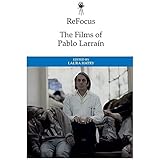ReFocus : The Films of Pablo Larraín / Laura Hatry.
Material type: TextSeries: ReFocus: The International Directors Series : RFIDSPublisher: Edinburgh : Edinburgh University Press, [2022]Copyright date: ©2020Description: 1 online resource (248 p.) : 29 B/W illustrationsContent type:
TextSeries: ReFocus: The International Directors Series : RFIDSPublisher: Edinburgh : Edinburgh University Press, [2022]Copyright date: ©2020Description: 1 online resource (248 p.) : 29 B/W illustrationsContent type: - 9781474448284
- 9781474448307
- 791.430233092
- online - DeGruyter
| Item type | Current library | Call number | URL | Status | Notes | Barcode | |
|---|---|---|---|---|---|---|---|
 eBook
eBook
|
Biblioteca "Angelicum" Pont. Univ. S.Tommaso d'Aquino Nuvola online | online - DeGruyter (Browse shelf(Opens below)) | Online access | Not for loan (Accesso limitato) | Accesso per gli utenti autorizzati / Access for authorized users | (dgr)9781474448307 |
Frontmatter -- Contents -- List of Figures -- Notes on Contributors -- Acknowledgments -- An Introduction. Pablo Larraín: Doomed to Repeat It -- 1 A Cracked Gaze: Pablo Larraín’s Cultural Context -- 2 The Synecdochic Series of Pablo Larraín: The Castro Cycle of Chilean Complicity in Fuga, Tony Manero, Post Mortem, No, El Club, and Neruda -- 3 “Within the Limits of the Possible”: Realist Aesthetics in Pablo Larraín’s Dictatorship Trilogy -- 4 When Violence Meets Experimentalism: Unraveling Cinematic Suture in Raúl Ruiz’s Tres Tristes Tigres and Pablo Larraín’s Post Mortem -- 5 Gothic Memory and Ghostly Aesthetics: Post Mortem as a Horror Film -- 6 Aestheticization of Politics and the War Machine in No by Pablo Larraín -- 7 Adaptation and the Use of Documentary Material in No -- 8 The Blurred Image: The Aesthetics of Impunity in Pablo Larraín’s No and El Club -- 9 Reimagining the Left in Neruda: Inclusivity and Encounters with Secondary Characters -- 10 Surfaces in Jackie: Representing Crisis and the Crisis of Representation -- 11 “When on Stage, I Am Not There, I Am Not That One” An Interview with Alfredo Castro by Arturo Márquez-Gómez -- Index
restricted access online access with authorization star
http://purl.org/coar/access_right/c_16ec
The first English-language collection of critical essays on the Chilean director Pablo LarraínProvides cultural and historical context for Larraín’s films, including consideration of his own influencesAssesses Larraín’s standing in Chilean film and his cinematic style through close analysis of all his worksAnalyses Larraín’s oeuvre in the context of film aesthetics, philosophy, history, adaptation studies, and cultural studiesPablo Larraín is among the most prominent filmmakers in contemporary Chilean cinema. Having created a highly original cinematic language and established a focused critical dialogue about Chile’s troubled contemporary history, his work presents an unflinching portrait of one of the most notorious regimes of modern Latin America (indeed, the world) and its problematic aftermath. In a straightforward, often surprising, and reliably controversial series of films, Larraín never retreats in the face of violence or the painful truths that still undergird Chilean reality. Assessing his work in the context of film aesthetics, philosophy, history, adaptation studies and cultural studies, ReFocus: The Films of Pablo Larraín is the first book-length English-language anthology about this important director’s cinema, offering a wide range of perspectives by a diverse range of international scholars.
Mode of access: Internet via World Wide Web.
In English.
Description based on online resource; title from PDF title page (publisher's Web site, viewed 29. Jun 2022)


